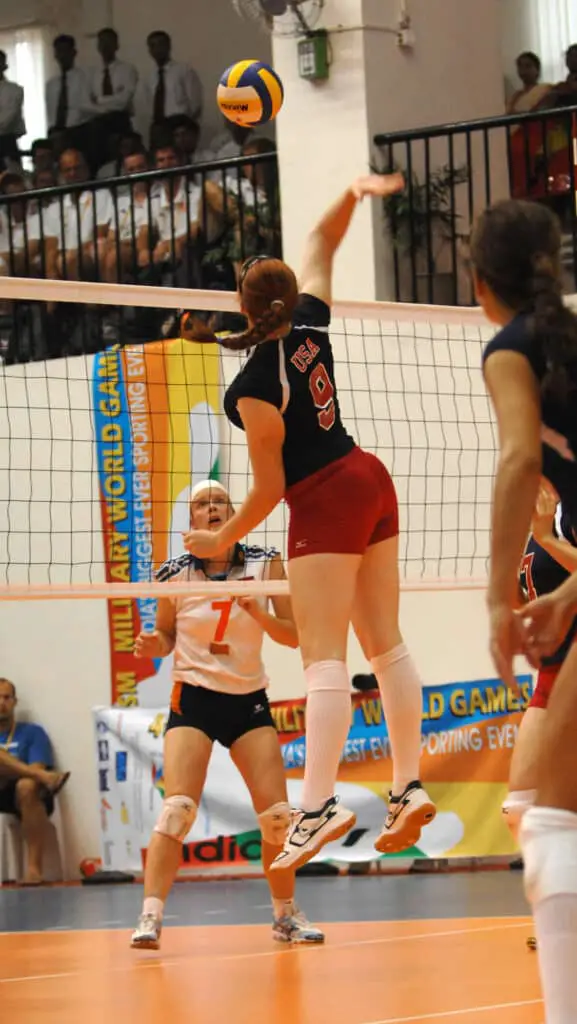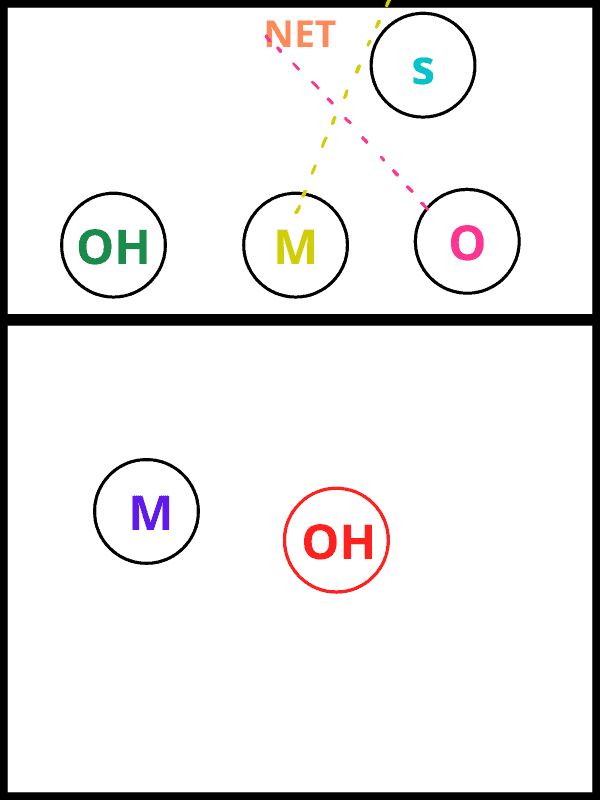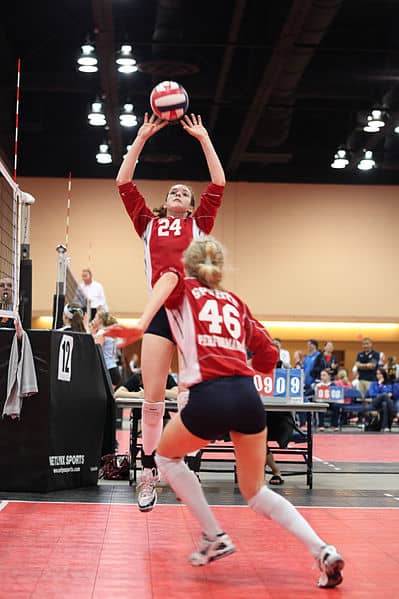Sometimes in volleyball when playing a stronger team you can’t rely on the traditional hitting lines, that being outside hit, middle hit and the opposite hit.
Fortunately there are lots of different strategies we can implement to outsmart our opposition.
One play which I absolutely love and can leave teams looking silly is the X Play.
The X attack in volleyball is a combination play in which the middle and the wing spiker switch positions, the middle will run and jump as they normally would while the wing hitter runs in late behind the back of the middle to spike the ball.
This tactic has many benefits and more often than not results in a free point for the team running the play, this is because the wing spiker running the X is often left with no block and a free net.
As we know in Volleyball when a hitter is left with a free net this is almost a guaranteed point.
Table of Contents
What is an X Attack
So as I touched on above the X play is a combination play that requires the wing spikers and middle to all be in the loop, without all players knowing the plan before the play starts this attack will fail.
The X attack can be run in two different ways, either the middle and opposite can run the play or alternatively the outside hitter and middle can run the play.
Let’s first look at the middle and opposite hitter
Outside Hitter & Middle X Attack

Prior to the play starting the setter, middle and outside hitter must ensure they all agree on the play.
Once the first pass has gone in, the middle hitter will start their approach however it is vital they run a 2/ b, this is essentially where the middle keeps approximately a 2m distance from the setter, so that the setter can chute the ball to the middle as opposed to the traditional middle hit which is right on the setter.
The reason the middle must run a 2 or b play is because the distance between the middle and setter will be filled by the outside hitter running the X attack.
As the middle starts to run this chute play they should be pulling the middle blocker on the opposition team away from the centre of the court and more towards the wing where the outside hitter would traditionally be.
As the blockers on the opposition start to move over the middle will jump like they are about to be set the ball, the setter will set a meter ball (this is set that is approximately 1m above the height of the net, it is a shorter set but not as quick as a traditionally short) right in front of them rather than setting the middle.
As the setter releases the ball the outside hitter will run diagonally towards the set and hit the ball over on hopefully a free net with no blockers.
If you are unclear on how the play will look, I have inserted a diagram below which may clear this up for you.

Opposite & Middle X Attack
The Opposite and Middle X attack is almost identical as the above noted method however it is done from the opposite side and the middle must act slightly differently in this play to ensure the opposite has free court to run in.
In this play again it is vital the opposite, middle and setter all know the play prior to the rally starting to avoid any confusion or miscommunication.
Once the first pass goes in the middle will run a traditional 1 or a attack, this is where the middle hits a short ball right next to the setter, this creates space between the middle and the outside hitter.
As the ball travels towards the setter the middle will start their approach to try and sell to the opposition that the middle is about to spike the ball.
As the setter releases the ball the middle will be in the air ready to hit, the setter will instead place the ball just above the middle and give the ball enough energy to ensure it lands in the hitting window between the middle and outside hitter.
When the opposite sees the setter is about to release the ball they will make a bee-line diagonally towards the set location just behind the middle and spike the ball, again hopefully over a free net with no blockers.
Again I have put a diagram in below to represent this.

Why might you run an X Attack
So I started touching on this above but one of the main reasons why you might want to run an X attack is to outsmart a team that might be potentially stronger than yours.
If you are playing a good team who keeps shutting down your attack, using plays such as this might just tip the scales in your favour and give your team the boost they needed.
Alternatively I have also used this play when our team is playing really well and feeling confident, executing a play like this isn’t always the most simple attack to pull off and therefore you may feel like using the X attack when you’re feeling confident.
Whatever your reason for using this play I would suggest maybe getting a few reps in during training to get the basics down before you go into your game.
Drawbacks of the X Attack
The drawbacks of this play are it involves quite a few players and requires everything to go smoothly to get the most out of this attack.
As with all plays in volleyball the first pass is vital.
First Pass
If the pass isn’t perfect the opposition will instantly assume the set is likely not going to the middle and therefore they will be more ready to block wing spikers and more alert to trick plays.
The next thing that can cause issues to this play is if the middle doesn’t run the correct play or alternatively doesn’t sell the play enough meaning the blockers on the opposition stay in the centre of the court and watch the set.
Middle Blockers

If the X attack you are running is the outside hitter and middle combination it is vital the middle runs a chute play also known as a 2 set or b set,
If the middle does not go wide enough and leave enough space or even completely runs the wrong play it would cause a lot of issues. The set will be too high for the middle to spike and the outside hitter will have no way of reaching the ball because the middle is in the way.
In the other situation where the middle does run the right play but doesn’t create enough space this could make the outside hitters life very difficult or alternatively it may not draw the blockers far enough away to leave the outside hitter a free net.
Another issue that may rear its head will be the wing hitters, this play fails if the wing spikers forget the play or alternatively don’t get the timing right.
Wing Hitters
If the wing spikers forget the play this will obviously leave a set with no attackers in the correct area to hit or return the ball.
If the wing spikers don’t get the timing right this can lead to a couple of different issues, if the wing spiker begins to move too early the opposition will be able to notice the movement and read the play, thus taking the element of surprise out of the play.
If the wing spiker moves to late they may not be able to meet the set at a sufficient height to spike the ball, if the ball starts to fall below the height of the net the wing spiker will need to play a defensive shot to ensure they don’t spike the ball into the net or out of the back of the court by forcing the hit.
The last issue with this play lies in the setter.
Setter

The success or failure of this play relies heavily on how good the set is, it is vital that the setter sells the play by aiming for the middle whilst setting a nice meter ball for the wing spikers to hit.
If the setter is not deceptive enough the opposition may be able to read the play and set up a sufficient block.
In the other situation regarding the position and height of the set, if the setter places the ball too wide the wing spiker will be reaching to attack the ball and thus making the play less effective, alternatively if the set is not wide enough they will be competing for the ball above the middle which may cause some collision issues.
Regarding the height of the set. If the set is too high the wing spiker will have to slow their approach down so much that the blockers will likely be able to reset ready to block, alternatively if the wing spiker continues to run the play with the set too high they may miss the ball completely.
If the set is too low the attacker will be unable to spike the ball with any conviction and will likely have to play a defensive shot to ensure the point is not lost due to a hitting error.
How to Know when to run an X Attack
The X attack can be used at any time throughout a match however there are a few things that are worth noting or looking out for to increase the likelihood of success when running this play.
The first thing to note is something I have repeated throughout this article.
You need to ensure all parties are aware of the play otherwise this attack will not work.
The next thing that is vital to the success of this play is the first pass, if you plan on running the X attack but you notice the first pass is off I would definitely recommend calling an audible and switching the play, it isn’t worth giving away the trick play until the circumstances are right.
Some other things that are worth looking out for is how easily the middle blocker is sold by your middle, if the middle is very disciplined and good at reading the game they may be smarter than the X play, if you notice that they jump nearly every time your middle commits the play should work wonderfully.
Well that about sums it up, so get out there and start playing around with the X attack.
